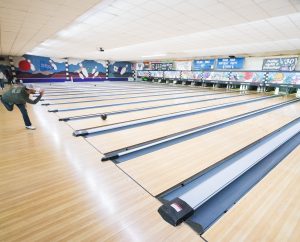Completely renovated landmark is one of Arizona’s longest running alleys.
That’s the numbers game for Starlite Lanes, Flagstaff’s only bowling center and one of the state’s oldest bowling alleys. But old, in this case, does not mean outdated.
Since buying the business in 2010, Starlite owner Ron Getto refurbished the building with a new roof, flooring, seating and other improvements. He also modernized Starlite with state-of-the-art pinsetters, cosmic lighting and a digital scoring system with lane-to-lane communication.
“Like anything, technology has improved the sport and recreation of bowling,” said Getto, a former hedge fund CFO, who has become the kingpin of Flagstaff bowling, even though he’s never been a bowler.
High-maintenance wooden lanes have been replaced by synthetic surfaces. Bowling balls have advanced from hard rubber, to polyurethane, to reactive resin, an advanced form of polyurethane.
Starlite opened as a Baby-Boom-era bowling alley in 1957 when the blue-collar game was exploding across America. It was the pickleball of its era. Sports pages were full of league standings and bowling columnists shared news about keglers, a now outdated term for bowlers.
Stay-at-home moms with beehive hairdos had morning leagues. Men hit the lanes after work. Kids bowled in Saturday morning leagues or at birthday parties.
Bowling alleys are no longer smoky, but bowlers at Starlite still enjoy everything from craft beers to White Russian cocktails at its Side Door Lounge.
The Starlite building, a midcentury-modern gem with a decorative brick screen wall, is oddly juxtaposed with the 1930s Museum Club log cabin. The unlikely pair of entertainment venues have been Flagstaff staples for many generations.
Bowling in Arizona goes back at least 145 years. State historian Marshall Trimble reported that Vogan’s Saloon in Tombstone had bowling as early as 1879. Downtown Phoenix had the underground Gold Spot Bowling Alley from 1939-1950.
Arizona Highways featured a story on Phoenix Bowl-Air, 14 outdoor lanes of concrete that opened in 1940. Twin 25-foot bowling pins anchored the Bowl-Air sign.
Bowling in Flagstaff goes back close to 125 years. The 1899 Verkamp Building southeast of San Francisco Street and Aspen Avenue had bowling in the basement, as reported by The Coconino Sun.
Drug stores operated in the building’s street-level space. The Benevolent and Protective Order of Elks occupied the second floor and the building became known as Elks Hall.
In 1916, rowdy behavior at a Southside pool hall led the Town Council to require pool halls and bowling alleys to close between midnight and 7 a.m. Violators faced three months in jail or a $300 fine, equivalent to $8,850 today.
Mountain Sports currently occupies the Verkamp Building. Few remnants of the bowling alley remain.
Other Flagstaff-area bowling alleys included:
The Navajo Ordnance Depot, which built four lanes for its workers in 1944, according to historian John Westerlund.
In 1961, Roll-A-Bowl opened in Winslow. It burned down in 1983.
Northern Arizona University installed six bowling lanes in the North Campus field house in the late 1960s, and closed roughly 20 years later.
Len and Ida Sonka opened Sky-Hi Lanes on Main Street in Sunnyside in 1957, a few months before Starlite. It closed in spring 2000.
Bowling alleys have gone dark across America through the past five decades. In 1980, the U.S. Bowling Congress estimated there were 10,000 U.S. bowling centers. Now, the number is down to about 3,800.
The Arizona State Association of the U.S. Bowling Congress lists 40 certified bowling alleys in Arizona, 24 of them in metro Phoenix.
Getto, 62, said he grew interested in buying a bowling center when business conditions flipped and demand exceeded supply.
“I recognized what a great business it can be,” he said.
Now, Starlite is the only game in town and it relies on local bowlers to keep it profitable, including league and recreational bowlers.
A group of league bowlers — Scott Turco, Alex Herring, Franky Lynch and E.J. Ahrendt — were bowling on a snowy Tuesday night even though their league game had been canceled because of the storm. Most of the lanes were empty.
“We have a lot of fun bowling in the league because we don’t take it too seriously,” said Lynch, 34, a financial advisor with Strategic Financial Planning.
Starlite’s revenue split is 50% from bowling, with leagues contributing 15% of the bowling business. The Side Door Lounge adds 25% of revenue, food is about 20%, while arcade games, retail and a pro shop kick in 5%.
Starlite briefly had competition from Bowlski’s 66. It opened with 12 lanes in fall 2022 at Flagstaff Mall but has since closed.
Getto is already gearing up for the 100th nniversary of Route 66 in 2026. He’s planning a giant mural on an outside wall celebrating Flagstaff’s dark-sky heritage with whimsical spaceships shaped like bowling pins and bowling ball planets. FBN
By Peter Corbett, FBN
Photo by Austin Corbett, Point to Point Photography: League bowler Franky Lynch aims for a spare on an alley at Starlite Lanes.





